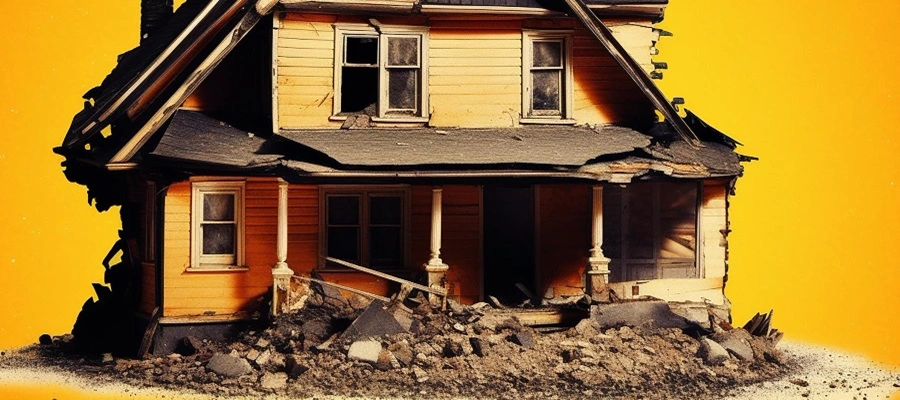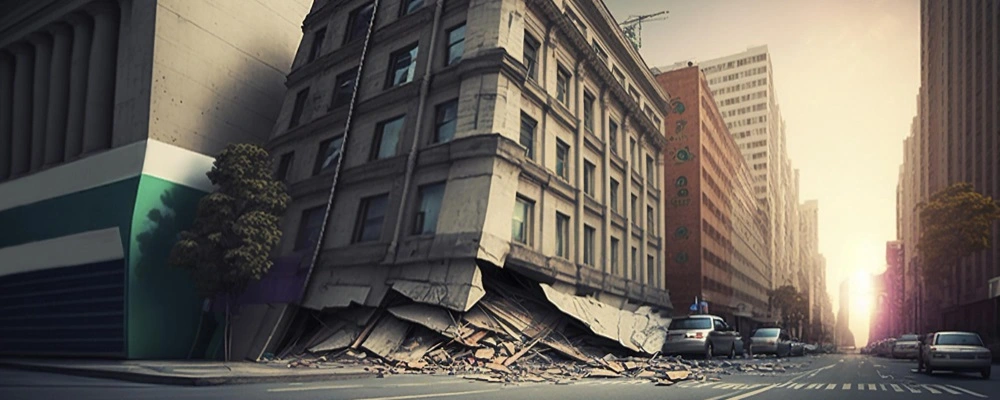Constructing your dream house requires hard work and dedication. However, we are continuously experiencing unpredictable patterns in climate change, such as strong winds, floods, earthquakes, and other natural calamities, which can damage your loveable home.
We often hear about building collapse. These are tragic events resulting in devastating consequences, including loss of life, injury, and widespread destruction of property. It’s crucial to understand the causes behind these collapses and implement effective preventive measures to ensure the safety of human lives and infrastructure. The urgency of this task cannot be overstated.
What is Building Collapse?
A building collapse refers to a sudden structural failure. It can either result in partial or entire failure of a building, threatening human life and health. The failure of the load-bearing structure of a building combined with the pulling of the exterior structure into the falling structure results in the building collapsing into itself. The scenario might result from construction activity, an earthquake and fire, often resulting in a defence debris field with a small footprint. Alternatively, suppose the building experiences an explosion or natural forces, such as weather-related structural failure. In that case, the building might collapse in an outward direction, causing a less dense and more scattered debris field.
Causes of Building Collapses
You can categorise building failures into two broad groups- structural and application failures. Some of the most common causes of building collapse include the following.
1. Weak Foundation
Strong foundations are essential for the overall structural integrity of your building, especially in coastal areas. Rising sea levels and coastal flooding, combined with soil subsidence, result in the gradual sinking of buildings.
2. Poor Quality Construction
In India, most building collapses happen due to inferior-quality raw materials, an inefficient workforce, and inadequate supervision while constructing multi-storey structures. Several construction firms are careless about the load-bearing elements, including columns and beams. Contractors often shift the location of kitchens and bathrooms to meet clients’ demands without consulting structural experts and engineers. Both of them can add to the problem causing building collapse.
3. Faulty Construction
Often, contractors work hastily to save time while constructing a building. In such a scenario, they often make errors, affecting the strength and integrity of the structure. Alternatively, if a construction company hires untrained workers, they might make serious mistakes affecting the building’s safety.
Construction errors that might cause tragic consequences include:
- Failure to properly waterproof and drain water from the foundation.
- Improper installation of windows and roofing materials, causing moisture intrusion.
- The lack of insulation in pipes causes condensation and damage to nearby materials.
- Selecting the wrong materials for the construction work. Contractors often use the same materials to construct buildings in the inland and coastal regions. These materials are inappropriate for buildings in the coastal regions, as corrosion and erosion are constant concerns.
4. Water Seepage
Rainfall is a natural factor that causes buildings to collapse. Therefore, it’s essential to construct buildings according to the climatic conditions of the region. Most seepage-related issues arise only during the monsoon season, causing problems like rusting and internal leakages.
5. Failure to Perform Strength Tests
Contractors must conduct strength tests throughout a building’s construction. It includes load testing, which helps contractors determine the amount of load a building or structure can safely support without resulting in cracks and other damages. The contractor must also test the concrete to ensure that the building can properly support the structure’s weight.
6. Corrosion
Corrosion is a particular problem in coastal areas like Chennai. The presence of salt and chloride in groundwater results in corrosion and weakening of the materials. Over time, it affects the structural integrity of the building. Ensure that the contractor builds the building with corrosion-resistant metals, such as stainless steel, or with metals treated and coated to become corrosion-resistant. If left untreated, corrosion can weaken cross-beam reinforcements, leading to structural failure.
Types of Building Collapse

Some of the classifications of collapse, both in process and severity, are mentioned below.
Partial and Complete Collapse
The term partial collapse refers to collapses when the elements or some of the areas of a building fail for various reasons, and the majority of the structure remains standing. Complete collapse, on the other hand, refers to the collapse when the entire structure collapses as a whole, either through staged collapse or in a singular collapse.
Disproportionate Collapse
Disproportionate collapse, often referred to as cascade failure, results in the failure of one component of a building. It often leads to the progressive failure of another or a series of other components. This type of collapse can often lead to the partial or complete collapse of a structure.
Symmetrical Collapse
Symmetrical collapse is similar to partial collapse occurring in small buildings. The collapse mostly occurs at the centre or edges of the buildings, where some elements remain standing. Building collapse risks are lower in taller buildings, as the significant weight of the higher floors might result in total collapse. This type of collapse creates either a V or A-shape in the debris.
A-frame Collapse:
Often described as a tent collapse, you can see that the floors get separated from the exterior supporting walls. However, the central interior supporting walls of the building, along with the support part of the floor directly above, remain intact. The collapse results from weakness and shear forces at the junction between the external supporting walls and the floors. The falling of the edges with the supporting of the centre resembles an A-shape. Experts often describe sitting as a progressive collapse when the failure of the floors causes the central supporting wall to collapse due to extra weight.
V-frame Collapse:
It occurs in buildings where beams fail at their centre point due to overloading or damage, including rotting and weathering. It is common in buildings with few or no central structural supporting walls. The building experiences failure in the centre of the structural member, whereas the external walls remain intact, forming a V-shape from the debris left.
Asymmetrical Collapse
Asymmetrical collapse includes the following:
Lean to Collapse:
In this type of collapse, one or more load-bearing walls fail. You might witness the removal of one-half of the structure while the connection points remain, and the bending moments cause the remaining elements to lean to one side. If the remaining connection points give way to shear forces, the floor might fall or stack to the ground. The remaining wall might not remain standing.
Cantilever Collapse:
It refers to the failure of a building where a beam supports the building only at one end, and the overhang carries the load. This type of building might experience progressive collapse, starting with the failure of one of two elements of the single-sided structure.
Precautions for Preventing Building Collapse
The following are the most effective techniques for a company to prevent building collapse.
1. Awareness of Construction Area’s Standards
Before constructing a building, a construction firm must study the area and check the quality of the soil and the land. If the land is swampy, it will make the construction of the building difficult.
2. Check the Foundation
Are you wondering if the building is strong? If yes, the best way is to ensure the foundation is strong. Before constructing a building, it is essential to check the soil of the ground where you want to construct your building. Building a good foundation will be challenging if the place is swampy. In such a situation, the construction firm must take extra care of the foundation. A solid foundation makes a building strong, making it strong enough to withstand any blow. Hence, choosing the right foundation for your home is a must.
3. Avoid Major Alterations
Certain alterations often affect the structure of the building, so contractors must avoid them at all costs. Clients often request to change the interiors, which requires breaking the wall of the flat or breaking the beam supporting the building. Doing so can cause severe damage to the building. Therefore, before making any alterations, it is important to determine if they would affect the structure of the building.
4. Build Earthquake-Proof Construction
Construction firms must build firm foundations to prevent the building from collapsing during an earthquake. Before constructing a building, construction firms must pre-plan, making your building stable and strong. Pre-designing must include ways to make the building more ductile so that it can withstand earthquakes.
5. Seeking Help of a Professional Structural Engineer
Before constructing a building, you must seek consultation from a professional structural engineer with the right experience. When you hire a professional structural engineer, the professional will help you build a strong building that can withstand any weather. Besides, their designs are professional and accurate.
Conclusion
Building your dream home takes months or even years, and when the builder fails to meet the standards, the building might collapse. Building collapses represent a significant threat to public safety and infrastructural integrity. Preventing a building’s collapse isn’t the responsibility of just one party. Construction companies must analyse structural defects as a priority and hire qualified engineers for regular inspections and evaluations.As India’s leading construction firm, Brick & Bolt handles all the investigations and evaluations, such as soil testing and digital surveys before building your dream home. The professional team of experts associated with the organisation considers even their customers’ minutest demands, keeping in mind that they do not hamper the safety of the structure. From checking the land to delivering the keys to your dream home, Brick & Bolt uses technology like artificial intelligence and computer vision maps to analyse its quality and programs, streamlining management and predicting its progress.

